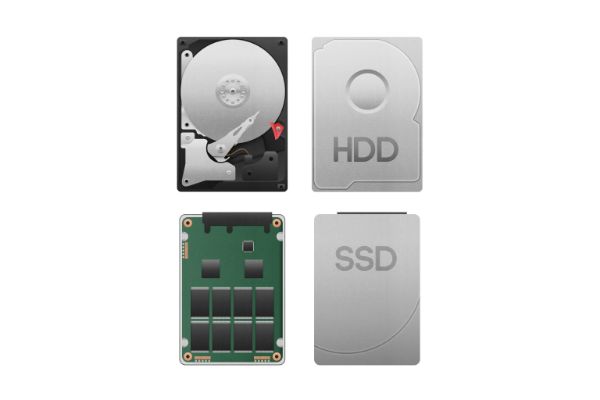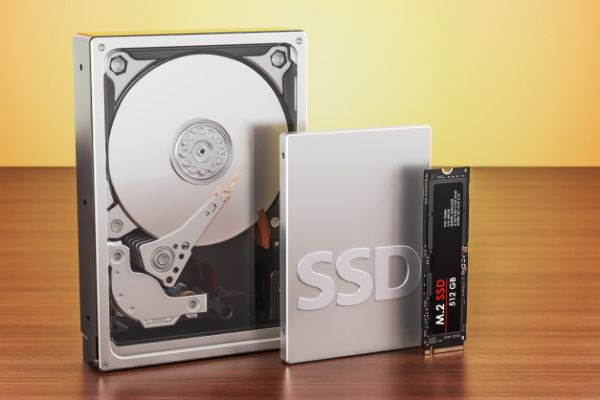Disclaimer: This post may contain affiliate links, meaning we get a small commission if you make a purchase through our links, at no cost to you. For more information, please visit our Disclaimer Page.
HDD and SSD usually show less space than advertised because there are differences between the Decimal and Binary systems. Computers operate using the binary system, but their space is advertised using the decimal system because people understand the capacity in this numeral system.
Table of Contents
Why Does HDD & SSD Show Less Space?
An HDD is an essential part of a computer that stores data on your device. This is a device that is included inside the computer, i.e. it lives in your PC, or otherwise, your computer will not function properly. HDD reads and writing data on the storage disk.
An HDD is a perfect tool that you need around for storing larger files, photos, or videos. It is quite practical because you can use it for data that does not need to be opened so frequently. However, if you need a lot of space for your files, you will need to ensure that you have the right HDD.
An SSD has the same purpose as an HDD, however, they have some differences in sizes, i.e. the amount of space they provide for storing data. They do not run by running a disk, so they are considered more practical, but usually for smaller devices, and not so many files.
SSDs are usually more expensive than HDDs, but that depends on the space they offer. However, you can access them more quickly, meaning that they are more convenient for use. So, people usually think of their use and then decide which one to purchase.
It can be quite annoying to discover that your HDD or SSD has less space than it is advertised on it. If you buy a hard disk or a USB flash drive for the first time and see that they have less space than they advertised it, you might think that you have been fooled.
You may buy an HDD that says 500 GB on it, but then you use it on your computer, and you see that the actual space is 465 GB. Some people do not really bother about these numbers, but others find it really confusing.
If you buy an HDD or SSD with a certain amount of space, you want that space at your disposal. This means that you would like to know where are the remaining gigabytes that were promised by the manufacturer.
However, you are not actually fooled, because there is a perfectly good reason why this is this way. Namely, you should not be surprised when you see less space on your HDD or SSD since this happens to everyone. The explanation lies in the difference between the Binary and Decimal systems.
Why Does My HDD & SSD Have Less Space Than Advertised?
The answer to this dilemma is actually very simple, but if no one has explained to you, then you are probably still confused whenever you try to find the perfect HDD or SSD. What you need to understand is basically the numeral system by which these storage drives are operated.
Namely, HDDs and SSDs have their storage capacity expressed in the Binary system. However, this system is quite complex and mostly understood by people who work in this field. The numeral system that most people understand is the Decimal system.
In order to make things simpler for people, manufacturers use the decimal system to express the storage capacity of an HDD or SDD. This way, people will understand what amount of space they will have at their disposal once they buy one of the storage drives. So, how are these two systems different?
The difference arises because the binary and the decimal systems are not equal, i.e. they do not represent the same numbers. Namely, in the binary system, 1GB equals 1024MBs, and not 1000MBs, as you would assume. That is why when you run your storage drive on your PC, you see that you have less space.
For instance, if you buy an HDD device that is labeled 1MB, you probably expect 1,000,000 bytes, when you insert it into the computer. However, since computers are operated by the binary numeral system, there will be differences in the numbers, i.e. the amount of space provided.
In other words, you may see one number that is advertised on your storage device, but the capacities will definitely vary. Computers operate in different ways with their numeral systems, so you should expect less space than it is labeled on your storage drive.
Therefore, you may use an HDD or SSD with a storage capacity of 500 GB, but your computer will convert these numbers into the binary system, and you will be left with 465 GB. People easily understood the decimal numeral system, and that is the primary purpose of its use on storage drives.
For people who are not really interested in the field of computers and technology, it might be still difficult to understand these notions. So, I have included a simple list of how decimal numbers are seen in the binary system. This kind of math might be beneficial to make things clear for you.
- Terabyte (TB) = 1,024 gigabytes or 1,099,511,627,776 bytes
- Gigabyte (GB) = 1,024 megabytes or 1,073,741,824 bytes
- Megabyte (MB) = 1,024 kilobytes or 1,048,576 bytes
- Kilobyte (KB) = 1,024 bytes
In a simpler way, if you buy a device that offers 1 MB, you do not get 1,000 kilobytes, but 1,024. The systems that operate your computer process and convert these numbers. Some newer operating systems in computers might use the decimal numeral system, but you still get the conversion.
Why Are Storage Devices Not Exact?
Due to the fact that consumers do not think in the same way as people in the field of computers and mathematics, nowadays, we have storage devices that show different storage spaces. Namely, manufacturers have decided that is easier to express the capacities in standard base-10 numbers.
These numbers are quite familiar to all of us, thus this decision is perfectly logical. If the storage space is expressed in a binary numeral system, a lot of confusion will be present. That is a fact.
That is why it is easier to rely on decimals, although you will have less space on your storage drive than advertised. Nonetheless, it is better to expect less space than it is written on than to deal with large binary numbers that half of the population does not understand.
If you want to understand the actual difference in numbers, you can easily just look at the list of differences I have included below:
- Megabyte difference = 48,576 bytes
- Gigabyte difference = 73,741,824 bytes
- Terabyte difference = 99,511,627,776 bytes
However, this math is not the same with all computers and all storage devices. That is why when buying a storage device, you need to be careful. In other words, you should not always expect the exact same numbers since your computer might process them differently.
This means that sometimes you might end up with the exact storage space as it is advertised on the storage drive. If these details are of crucial importance to you, it might be the wisest to always consult the sales assistant in the store where you buy your storage device.
It is definitely convenient to know your computer and the storage devices you buy because they can sometimes cost a fortune. You do not want to end up with something useless and unworthy of the money.


